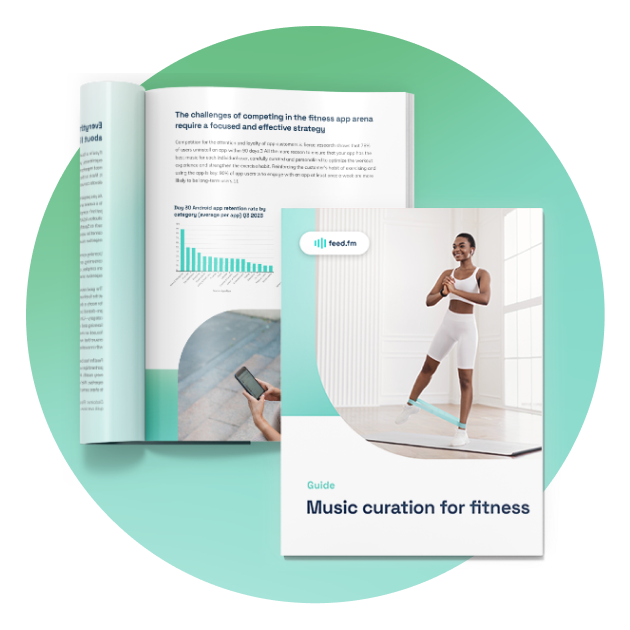Give your clients a personalized fitness music experience.
GUIDE
Music curation
for fitness
This guide proves how the blend of science, technology, and curation expertise can revolutionize fitness experiences through music.
Read on to learn how to use music to:
- Enhance fitness results
- Boost workout session times
- Amp up customer retention

Introduction
From the background music of Jane Fonda’s home workout VHS tapes in the 1980s to today’s fitness streaming platforms, the process of music curation for fitness and exercise has changed dramatically. This journey from those antiquated tapes to digital streaming has revolutionized the music curation process, going from mixtapes to algorithms that respond in real time to user preferences. AI holds the promise of improving the effectiveness of fitness music further, expediting this algorithmic alignment to highly personalized preferences. Simultaneously, the growing field of biomusicology and science-based music studies are providing curators with actionable insights about what types of music are most effectively paired with specific fitness and wellness activities.
Brands that are in tune with their customers are embracing personalization as a means of attracting and retaining users, increasing sales, and communicating a high-level understanding of their customers’ needs. When it comes to brand loyalty, a 2022 survey found that 74% of consumers rated “feeling valued and understood” as the most important contributing influence to loyalty.8 Meaningful experience personalization is becoming the key to maximizing engagement with users, and companies are taking notice, with 71% of B2C leaders reporting that “personalization has a significant or very significant impact on their brands’ customer strategies.”2
The opportunity for brands to offer science-backed streaming music in apps that can be personalized in the moment, either via AI and/or UX (including music menus, likes, dislikes, and skips), and is optimized for the user’s specific activity and goals, is new and unprecedented. With the emergence of unified music systems like Feed.fm, the opportunity for digital fitness companies to leverage expert music curation for fitness to drive music-led growth and extraordinarily enhanced user experiences is within reach.

How science-backed workout music amplifies fitness results
To quote one of the world’s foremost authorities on music for exercise, Professor Costas Karageorgis of Brunel University, “Music can be thought of as a legal performance-enhancing drug.”6 Research by Karageorgis and his team on the interplay of music with exercise and sports has generated a body of evidence that supports the assertion that “appropriate music selections can result in enhanced affect that is accompanied by greater work output and a reduction in perceived exertion.” To put it more plainly, expertly curated music played during workouts elevates the exerciser’s mood, and encourages them to work out longer and harder while making the workout seem easier. Furthermore, in a research study by Karageorgis and his colleagues, it was found that syncing music in time with a runner’s pace increased muscular endurance by 15% and reduced perceived effort by 12%.5
Controlled research studies in healthcare settings have shown that curated music experiences can result in more than just increased effort during the workout; they can also contribute to an increased commitment to exercise, with more time spent developing an exercise habit. A study in the journal Sports Medicine provided audio players to cardiac patients with playlists synchronized to their individual walking/running pace. After three months, these music-empowered patients spent an average of 70% more time exercising each week than the patients who did not listen to music while exercising.1

Music in sports performance training
Compelling anecdotal evidence for the power of music to motivate athletic performance comes from distance-running legend Haile Gebrselassie, who was known to run to the 1994 Eurodance hit “Scatman,” by Scatman John. In an interview with The Guardian, Haile explained that the song’s 136 bpm tempo perfectly matched his running pace.4
USA Track & Field, the official American governing body for the sport, seems to agree on the power of music for distance runners; in 2007, they banned earphones and music players from any official U.S. marathon, “to ensure safety and to prevent runners from having a competitive edge.”
Outside of track and field, the protocol around the use of music in sports is inconsistent. The only Olympic sport that allows music to be played—via headphones—during competition is skateboarding.7 Gymnasts always use music for their floor routines, but then they must listen to the floor routine music of other athletes while competing in the rest of their events. Swimmers are allowed to listen to music on headphones prior to their races, but not while swimming.10
U.S. Olympic athlete Austin Krajicek, 2024 silver medalist in men’s doubles tennis, has implemented music intentionally as a training tool. He has been using alphabeats, a mental fitness and performance app that combines curated music playlists with EEG sensor headwear to help users learn to control their production of alpha waves, which are associated with calmness and enhanced focus. Krajicek uses the music-driven training program when he wakes up, before practices, and before bed. “I really could notice a difference in my awareness of my states, during matches and then actually even translating off the court,” Krajicek reports.9
For the rest of us, music can be a powerful tool almost whenever and wherever we want it to be. And for fitness brands, the opportunity to use music to enhance your digital experience while contributing to your end users’ overall performance goals should not be undervalued. It pays to invest in a science-backed and data-driven music strategy that will move your users and move the needle when it comes to customer experience.

Music curation for fitness, driven by data
Feed.fm specializes in a data-driven music curation process that makes the most of our accumulated and ever-increasing knowledge to maximize the effectiveness and personalization of our music programming. Our curation team has analyzed data from millions of workouts and, just as importantly, spends time with fitness instructors across the globe to understand how they think about track selections for a class. Constructing a playlist for an in-person class during which you can get a read on the energy and participation of the exercisers is different from programming for an at-home fitness experience. In an app experience, you have to be even more confident in every track and its ability to motivate users, helping them maintain their pace, or raise or lower their heart rate as appropriate.
Feed.fm music curators start with understanding the end user as fully as possible. Making smart inferences based on age, gender, location, and frequency of workouts, our curators begin to establish programming parameters. Next, the team digs in to understand the workouts themselves, including the trainers’ intent, script, and flow. Once that’s clear, we combine nearly a decade of proprietary playback data with science-backed musical parameters to create bespoke solutions for fitness companies. The experience of our curators is literally unparalleled in terms of such musical considerations as:
- When intensity-based vs. BPM- or RPM-based programming is best
- The optimal mixture of known music and fresh, new tracks that will keep users highly motivated
- The ideal frequency in rotating classic, older songs within throwback stations, to ensure for example that Survivor’s “Eye of the Tiger” is played but not too frequently
- How lyrics and/or instrumentals affect fitness performance
The final element that overlays all the work that goes into music curation for fitness is brand. Many of the bigger boutique fitness chains struggle with the variability of music in their studios, as each instructor is responsible for their own curation. In a digital environment (web or apps) it’s crucial to balance personalization options with consistency, ensuring that all music selections reflect the brand. As but one example of Feed.fm’s best-in-class curation services, we implemented the music industry’s first MPAA-style rating system (e.g., G, PG, PG-13, etc.) to consistently classify and stream songs for our business partners. This guarantees brand alignment in the content and context of the songs 100% of the time.
Once the music is up and running, Feed.fm’s team incorporates usage data and qualitative feedback from exercisers, instructors, and our business partners to continually refine the mixes. So, while instructors have the advantage of live feedback in a class environment, digital curators have the benefit of data from many thousands of users to continually optimize the tracks and preferences.
The challenges of competing in the fitness app arena require a focused and effective strategy
Competition for the attention and loyalty of app customers is fierce: research shows that 78% of users uninstall an app within 90 days.3 All the more reason to ensure that your app has the best music for each individual user, carefully curated and personalized to optimize the workout experience and strengthen the exercise habit. Reinforcing the customer’s habit of exercising and using the app is key: 90% of app users who engage with an app at least once a week are more likely to be long-term users.11



Music moves your customers
One surprisingly simple solution to boost metrics sustainably across every phase of the acquisition funnel is to implement in-app music.
The research shows that music is a powerful workout enhancer—effort expended, time spent exercising, and commitment to exercise as a regular habit all are significantly improved.
So how can owners or publishers of fitness and sports apps and smart devices leverage this to their advantage? By baking music into the very essence of your product—making it a seamless, integrated aspect of the digital experience.
It’s not uncommon for Feed.fm customers to double their 90-day subscriber retention rate, and other key metrics in the subscriber funnel such as frequency of app use, length of session times, and conversion from trial to paid all benefit from in-app music integrations.
As shown in the graph below, expertly curated fitness music increases 90-day app user retention by 1.7x as compared with other music or no music. And listening to Feed.fm’s streaming fitness music increases exercisers’ workout times 3.2x compared with other music or no music.3
Want to join the fitness apps able to retain subscribers at rates that are head and shoulders above the competition? Contact our team to learn how Feed.fm’s unified music system can work for your app—we live and breathe music and fitness, and our product has been proven to drive value for fitness apps of all sizes. Drop us a line at sales@feed.fm to schedule a consultation to find out how expert music curation for fitness can benefit your app.
.gif?width=800&height=800&name=Retention%20Graphic%20Animated%20(1).gif)
Sources:
- Alter, D.A., O’Sullivan, M., Oh, P.I. et al. Synchronized personalized music audio-playlists to improve adherence to physical activity among patients participating in a structured exercise program: a proof-of-principle feasibility study. Sports Med - Open 1, 23 (2015). https://doi.org/10.1186/s40798-015-0017-9
- Crawford, L. (n.d.). Embrace meaningful personalization to maximize engagement, growth. The Wall Street Journal. https://deloitte.wsj.com/cmo/embrace-meaningful-personalization-to-maximize-engagement-growth-01658936783
- Feed.fm. (n.d.). The mobile app music report. https://info.feed.fm/hubfs/feedfm-inapp-music-drives-engagement-retention-roi-for-mobileapps.pdf
- Finn, A. (2013, May 10). Haile Gebrselassie: “In long distance, you have to be patient.” The Guardian. https://www.theguardian.com/lifeandstyle/the-running-blog/2013/may/10/haile-gebrselassie-interview
- Karageorghis, C. (2021). The ABC of music in exercise: Affect, behavior, and cognition [White paper]. https://www.feed.fm/the-abc-of-music-in-exercise-white-paper
- Karageorghis, C., Priest, D. Music in the exercise domain: a review and synthesis (Part I). Int Rev Sport Exerc Psychol. 2012 Mar; 5(1):44–66. doi: 10.1080/1750984X.2011.631026. Epub 2011 Dec 7. PMID: 22577472; PMCID: PMC3339578.
- Patterson, E. (2024, July 30). Olympic skateboarding explained: What are the rules around helmets, headphones and more. Wide World of Sports.
- Redpoint. (2022, Feb 9). 74 percent of consumers believe brand loyalty is about feeling understood and valued–not discounts and loyalty perks. https://www.redpointglobal.com/press-releases/74-percent-of-consumers-believe-brand-loyalty-is-about-feeling-understood-and-valued-not-discounts-and-loyalty-perks/
- Schaefer, R. (2024, July 24). Austin Krajicek on preparing for the Paris Olympics, using alphabeats for mental fitness. Sports Business Journal.
- Svetlik, J. (2024, Aug 2). Want to liven up the Olympics? Play a game of name those headphones. What Hi-Fi?
- Tafradzhiyski, N. (2024, June 14). Mobile app retention. Business of Apps. https://www.businessofapps.com/guide/mobile-app-retention/

